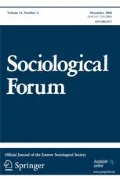Abstract
A parsimonious structural model of the four forms of suicide — egoism, altruism, anomie, and fatalism — defined in Durkheim'sSuicide is developed. The model explicitly defines the structural position of each form of suicide by focusing on duality of social structure, while retaining an analytic distinction between social integration and normative regulation. A payoff from this approach is that fatalism and anomie are interpreted in the same framework as altruism and egoism. The result is a consistent account of the four forms of suicide that is faithful to Durkheim's intentions to account for the aggregate suicide rate without recourse to the motivations of actors.
Similar content being viewed by others
References
Anderson, R. M., S. Gupta, andW. Ng 1990 “The significance of sexual partner contact networks for the transmission dynamics of HIV.” Journal of Acquired Immune Deficiency Syndromes 33:417–419.
Arendt, Hannah 1973 The Origins of Totalitarianism. New York: Harcourt Brace and Jovanovich.
1974 “The duality of persons and groups.” Social Forces 53:181–190.
1990 “Social control and social networks, a model from Georg Simmel.” In Craig Calhoun, Marshall W. Meyer, and W. Richard Scott (eds.), Structures of Power and Constraint: Papers in Honor of Peter M. Blau. Cambridge: Cambridge University Press: p. 453–476.
1951 Suicide: A Study in Sociology. (1897*) New York: Free Press.
1984 The Division of Labor in Society. (1893*) New York: Free Press.
Giddens, Anthony 1971 Capitalism and Modern Social Theory: An Analysis of the Writings of Marx Durkheim and Max Weber. London: Cambridge University Press.
Heckathorn, Douglas 1988 “Collective Sanctions and the Creation of Prisoner's Dilemma Norms.” American Journal of Sociology 94:535–562.
Johnson, Barclay 1965 “Durkheim's one cause of suicide.” American Sociological Review 30:865–886.
Jones, Robert A. 1986 Emile Durkheim: An Introduction to Four Major Works. Beverly Hills, CA: Sage Publications.
Levi-Strauss, Claude 1969 The Elementary Structures of Kinship. Boston: Beacon.
Lukes, Steven 1973 Emile Durkheim, His Life and Work: A Historical and Critical Study. London: Penguin Books.
Mauss, Marcel 1967 The Gift. New York: Norton.
Patterson, Orlando 1982 Slavery and Social Death. Cambridge, MA: Harvard University Press.
Rindfuss, Ronald, J. R. Udry, Barbara Entwisle, and Peter S. Bearman 1988 “Risk behaviors for AIDS and Pregnancy in Adolescents.” NICHD grant proposal.
Sattenspiel, Lisa 1990 “Modeling the spread of infectious disease in human populations.” Yearbook of Physical Anthropology 33: in press.
Simmel, Georg 1971 On Individuality and Social Forms. (1908*) Chicago: Chicago University Press.
Waller, Willard 1944 The Veteran Comes Back. New York: Dryden Press.
Author information
Authors and Affiliations
Additional information
This paper developed from lectures given in the Social Studies department at Harvard University in 1987.




